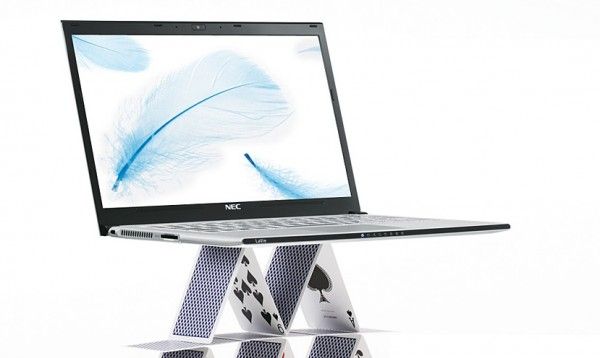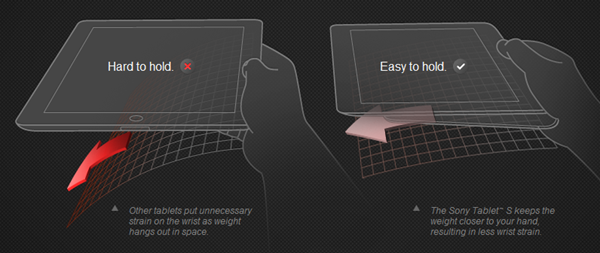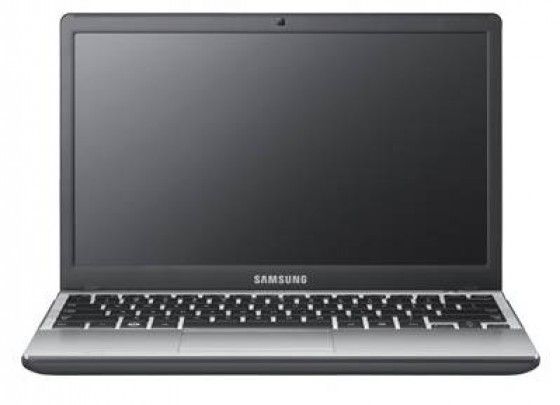At 875 grams, the NEC Lavie Z is the world’s lightest laptop with a 13.3″ screen. You’ll need to put up a pretty penny for the privilege of owning the world’s lightest 13.3″ computer, it has been priced by Dynamism at $1799. NEC is expected to launch the Lavie Z in mid-August and we’ve got full official specifications.
Tag Archive | "weight"
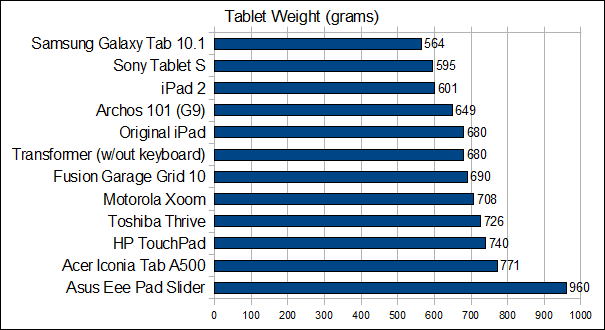
Top 12 Tablet Weights Compared — At 595 Grams, Sony’s Tablet S is the Second Lightest 10” Tablet on the Market
Posted on 01 September 2011
Though Sony’s Tablet S has been known about for months now, today they finally unveiled official specifications for the device. While weight isn’t the spec that everyone jumps at immediately, it’s certainly an important factor for a large 10” tablet. Sony says that their Tablet S is just 595 grams, which makes it the second lightest of the top 12 tablets, right between the Samsung Galaxy Tab 10.1 and the Apple iPad 2 (with the Tab 10.1 being the lightest) – quite impressive considering that the Tablet S design isn’t as thin as many of the other tablets on the market because of it’s interesting folded shape, though it should count itself lucky to be considered a 10″ tablet when the screen is actually only 9.4″. Have a look at how the top 12 ten inch-category tablets compare:
I would love to be able to say that tablets are getting lighter as time goes on, but as you can see, there are four Honeycomb tablets that were released after the first (the Xoom) that are actually heavier (though the Eee Pad Slider sort of has an excuse!).
The Tablet S is only about 1% lighter than the iPad 2, but Sony designed it with that funky shape specifically to make it feel lighter in one hand by grouping the weight on one side and reducing leverage again your hand. I’d be curious to see how much torque the iPad 2 puts on a hand vs. the Tablet S.

Top 12 Tablet Weights Compared — At 595 Grams, Sony’s Tablet S is the Second Lightest 10-inch Tablet on the Market
Posted on 01 September 2011
Though Sony’s Tablet S has been known about for months now, today they finally unveiled official specifications for the device. While weight isn’t the spec that everyone jumps at immediately, it’s certainly an important factor for a large 10 inch tablet. Sony says that their Tablet S is just 595 grams, which makes it the second lightest of the top 12 tablets, right between the Samsung Galaxy Tab 10.1 and the Apple iPad 2 (with the Tab 10.1 being the lightest) quite impressive considering that the Tablet S design isn’t as thin as many of the other tablets on the market because of it’s interesting folded shape, though it should count itself lucky to be considered a 10″ tablet when the screen is actually only 9.4″. Have a look at how the top 12 ten inch-category tablets compare:
I would love to be able to say that tablets are getting lighter as time goes on, but as you can see, there are four Honeycomb tablets that were released after the first (the Xoom) that are actually heavier (though the Eee Pad Slider sort of has an excuse!).
The Tablet S is only about 1% lighter than the iPad 2, but Sony designed it with that funky shape specifically to make it feel lighter in one hand by grouping the weight on one side and reducing leverage again your hand. I’d be curious to see how much torque the iPad 2 puts on a hand vs. the Tablet S.

Ultrabook Cost – Samsung’s Series 3 Compared
Posted on 11 August 2011
You might be wondering why Ultrabooks are going to cost $1000 or more when similar, slightly heavier designs are coming in at 75% of the cost.
The Samsung Series 3 that’s just gone on sale gives us a good chance to do some comparisons and there’s two things we need to consider.
1) Market acceptance
2) Design, hardware, production costs
If you take a look at the Samsung Series 3 [at Liliputing], you’ll see it’s running the Intel Core i5 2nd-gen CPu just like the Series 9. In the Series 3 that’s selling for $735 now you’ve got a 2.3Ghz version rather than a 1.3-1.5Ghz version. The reason is, size.

Weights, Sizes, Battery Life and ‘Netbook’ Restrictions – What’s More Important to You?
Posted on 06 March 2011
I’m ready to consider an 11.6 or even a 12 inch screen now and its based on my requirement to run some more complex software on a device that has a higher resolution. The problem is, while I can bear a bigger footprint, I can’t bear much more weight.
My Gigabyte Touchnote with its Runcore SSD and 2GB upgrade has served me well for 2 years but with the extended battery I’m down to 4hrs so it really is time to think about something new. The Touchnote weighs 1.45KG in its current form and there’s no way I want to go above that; In fact I’m looking to get as close as I can to 1KG. I’m also looking to stay with ‘just enough’ CPU which keeps the price down and allows me to stay in the low-power, long-battery life bracket. For me though, ‘just enough’ means dual-core Atom N550/N570 or AMD C-50 and if I consider my video editing project, it could be higher than that.
As I look at devices like the ASUS EeePC 1015PN and the Samsung NC210 I see Windows Starter, 1GB and 1024×600 screens but weights below 1.25KG. There’s also the AMD C-50-based Toshiba NB550D and the EeePC 1015b which at 1.3KG offers 2GB and, we hope, Windows options. The Fujitsu Lifebook PH530 is an interesting 1.33KG option with Core i3 and an 11.5 inch screen but in the 12 inch range you really are looking at 1.5KG unless you are prepared to pay serious money.
With my Android tablet PC taking over some of my netbook work now (many of my shorter posts last week were done with the Galaxy Tab) I’m not worried about having 8hr battery life. A solid 4-5hrs is fine so perhaps that means I can go up with the CPU and down with the battery life.
I get the feeling that there are a lot of you out there that are in the same position. You’ve had your netbook for a year or two and you’re looking for another mobile productivity solution. So what’s your preference? Do you want to keep it small or light? Do you want to break out of the Intel netbook restrictions or are you happy to carry on inside their restrictions? Feel free to comment below and of course, if you have buying tips, lets hear them.
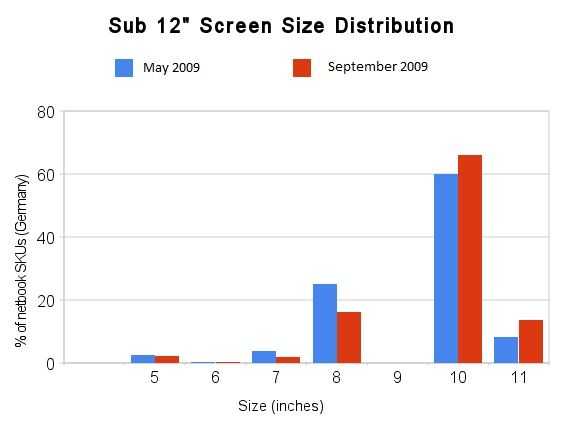
Screen Size Analysis. September 2009.
Posted on 07 September 2009
Back in May, I took a look at the small notebook PC market to try and determine the distribution of screen sizes. I took screen sizes of 11 inch and under and plotted them on a graph to find the unsurprising result that the 10 inch screen size was the most popular and the original 7 inch netbook had all but died. In May 2009, 68% of the devices had a screen that was over 10 inch. I also promised to revisit the subject. By taking a second snapshot today, I’m able to work out what sizes are growing and waning in popularity. It’s only a second data point but it’s very interesting.
There has been a huge growth in the 11 inch segment (and 12 inch but that’s out of scope for this mobile-computing-focused data set) which means that of all the SKUs, 79.6% are now 10 inch and over.
- 79% of devices have screens of 10 inch and over. (was 68%)
- The 11 inch segment grew by 65%
- The 5, 6, 7 and 8 inch segments all declined in % (and absolute number of devices available)
- The 8 inch segment declined by over 40% from 61 devices down to 45
- Linux-based devices still count for 8.5% of the devices (no change)
- 80% are over 1KG (12% increase)
- Nearly all netbooks under 1KG are 1st-gen devices that are outgoing.
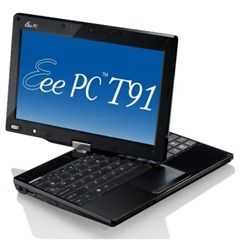 The sample size is 279 (up from 243)
The sample size is 279 (up from 243)- The cheapest device in the segment is the Hercules eCafe EC-800 based on the AMD Geode CPU. 160 Euros. Hercules also make the cheapest Atom-based device, the EC-900, for 190 Euros.
In general it’s a sad story for mobile computing fans especially as some of the best ultra-mobile solutions aren’t even reaching the normal online channels but there’s one shining star in amongst that lot. The ASUS EeePC T91 for 450 Euros, in Black, with a 24-month guarantee. 960gm, 5hrs battery life and a whole lot of flexibility!
As before, the results are based on data from the German/Austrian price comparison engine Geizhals.at and include all notebooks (and almost insignificant numbers of tablets and UMPCs) with screen sizes equal-to or below 11 inch. Again, I’ve put a note in my calendar to review the situation in 3-4 months time.
 |
| |||
 |
| |||
 |
| |||
 |
| |||
 |
| |||
 |
| |||
 |
| |||
 |
| |||
 |
| |||
 |
|

